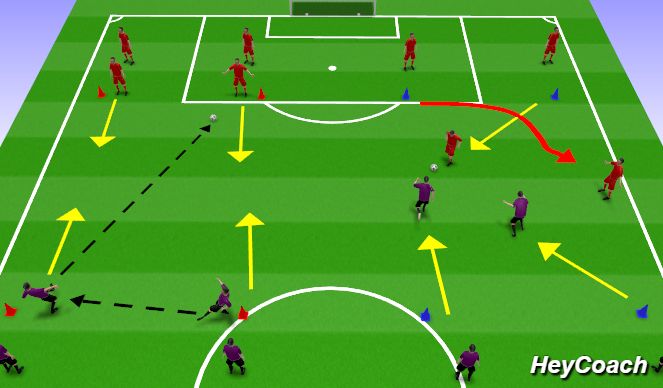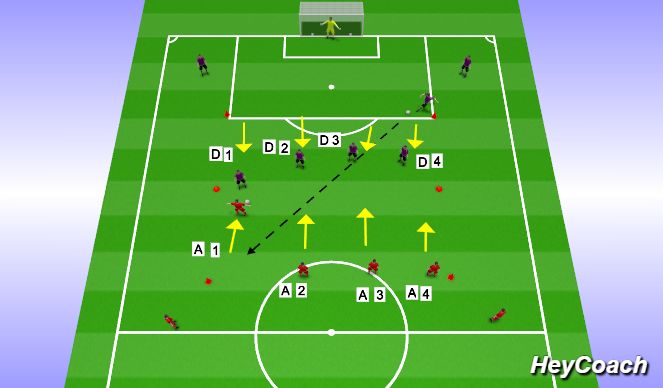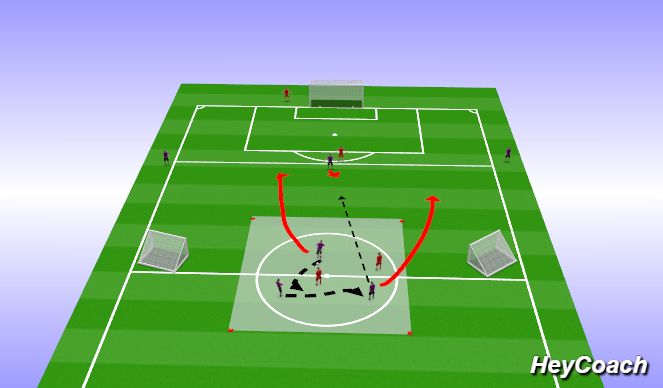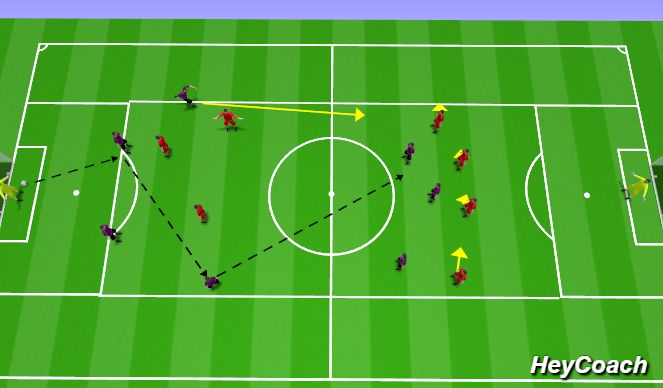
Defending:
Warm Up:
Players stand facing each other, with dribbling gates either side (Length of area 16 yards)
One player starts with the ball and he dictates the play, with the other "defending" and reacting to his movement.
The object of the game is for the attacking player to fake and change direction quickly, before attacking one of the target goals, forcing the defender to move his feet and recover. Players must stay on their own side of the centre line and cannot tackle to begin with.
Progression 1:
After a period of time, defending players are now allowed to "block" the gate by getting to the target area first and crossing the centre line to stop attacking player dribbling through. Once the attacking player changes direction, defending player can now chase and tackle
Progression 2:
Players can now move around the entire area (between all outside cones), resulting in a 3 v 3 possession game (as per diagram above, but can be any even split). Players remain with their partners, however, and this is the only person they can tackle

Component 1: Defending
2 v 2 defending channels
Defenders start with the ball and pass from one to the other. Receiving defender opens up and drives pass to opposite attacking player.
Attacking players progress with the objective of dribbling the ball over the defending goal-line. Defenders engage strikers and try to win possession. If defenders win possession, they can drive over the opposite line
Emphasis on the following:
Decision-making: Who presses the ball?
Communication: Where to show attacking player?
Speed: How quickly can you press the ball without over committing?
Angle of run from first defender: Cut off off pass and force 1v1?
Contact & Determination/Aggression: Using body to minimise space and can you win the ball?

Component 1: Defending (Part 2)
4 v 4 towards a goal
Defenders start on 18-yard box and drive or flight a pass to attacking players situated approx 40 yards from the goal (Variation of initial pass is important as this has a direct impact on when and how quickly to press)
Defenders must advance together, stopping attacking players driving over their defensive line (18-yard line)(No GK's initially, but one should be added later)
Emphasis on the same points in component 1, however now it is a 4 v 4 rather than a 2 v 2.
Decision-making is crucial as to who presses the ball - if Attacker 1 (A1) is in possession, then he is engaged by defender 1 (D1). If A1 passes to A2, then D1 retreats into a cover position, whilst D2 presses the ball.
Full-backs (D1 & D4) must remain ahead of deepest centre back (D2/D3), allowing this player to dictate off-side.
When D2 or D3 are pressing thier respective attacker, full-backs (D1 & D4) must narrow off, reducing the chances of a through pass and forcing play away from the goal
If the attacking player in possession drives towards the goal, then defenders must not over-commit and should deepen together until the opportunity to tackle arises.
Progression:
Add goalkeeper so that defenders must now realise when to press, when to drop and how deep to drop in order to prevent passes through and shots at goal.
GK must also communicate with defenders in order to defend as a unit
Players should be aware of offside

Combination
3v2 in 20x20 area. 3 attackers connect 3 passes, then two of the three midfielders play forward into the #9 (Forward) and the two midfielders & forward combine to goal. Players look for combination play (Wall pass, overlap, etc.) to create space to go to goal. Offside line keeps defender high. Defender may score in counter goals.
Variation 1: Defending midfielders may drop in when ball is played to #9.
Variation 2: Add #7 & #11 Attackers + 2nd Defender @ back line
CP: Angles of support, quick transition, communication, timing & weight of passes

Game-Related Practice: Defending
Players are organised into two equal teams with 4 defenders and 3 strikers in each half, plus goalkeepers.
The defending team maintain possession until a suitable opportunity to pass into the attacking half becomes available. To begin with, defenders must remain goal-side until strikers take their first touch. One defender can progress into the attacking half, creating a 4 v 4 and attacking team try to score.
If the defending team win possession, they attack quickly on the counter-attack, creating a 3 v 3 or 4 v 3 if they support quickly enough.
Players should be aware of offside
Progression:
1. Defenders don't need to remain goal-side when pass is played forward
2. Remove zones and play 7 v 7 game